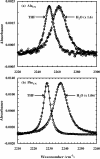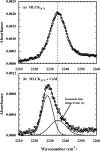Site-Specific Spectroscopic Reporters of the Local Electric Field, Hydration, Structure, and Dynamics of Biomolecules
- PMID: 22003429
- PMCID: PMC3192500
- DOI: 10.1021/jz201161b
Site-Specific Spectroscopic Reporters of the Local Electric Field, Hydration, Structure, and Dynamics of Biomolecules
Abstract
Elucidating the underlying molecular mechanisms of protein folding and function is a very exciting and active research area, but poses significant challenges. This is due in part to the fact that existing experimental techniques are incapable of capturing snapshots along the 'reaction coordinate' in question with both sufficient spatial and temporal resolutions. In this regard, recent years have seen increased interests and efforts in development and employment of site-specific probes to enhance the structural sensitivity of spectroscopic techniques in conformational and dynamical studies of biological molecules. In particular, the spectroscopic and chemical properties of nitriles, thiocyanates, and azides render these groups attractive for the interrogation of complex biochemical constructs and processes. Here, we review their signatures in vibrational, fluorescence and NMR spectra and their utility in the context of elucidating chemical structure and dynamics of protein and DNA molecules.
Figures




References
-
- Tadesse L, Nazarbaghi R, Walters L. Isotopically Enhanced Infrared-Spectroscopy – A Novel Method for Examining Secondary Structure at Specific Sites in Conformationally Heterogeneous Peptides. J. Am. Chem. Soc. 1991;113:7036–7037.
-
- Decatur SM, Antonic J. Isotope-Edited Infrared Spectroscopy of Helical Peptides. J. Am. Chem. Soc. 1999;121:11914–11915.
-
- Huang CY, Getahun Z, Wang T, DeGrado WF, Gai F. Time-Resolved Infrared Study of the Helix-Coil Transition Using C-13-Labeled Helical Peptides. J. Am. Chem. Soc. 2001;123:12111–12112. - PubMed
-
- Decatur SM. Elucidation of Residue-Level Structure and Dynamics of Polypeptides via Isotope-Edited Infrared Spectroscopy. Acc. Chem. Res. 2006;39:169–175. - PubMed
Grants and funding
LinkOut - more resources
Full Text Sources

